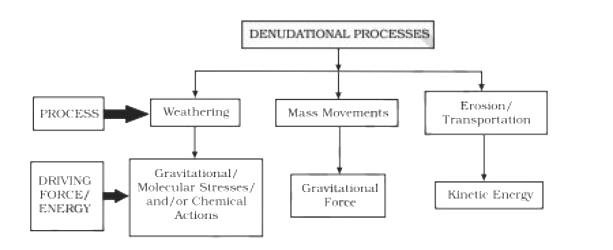





Geomorphic Processes - Geology & Geography
Geomorphic Processes – The earth’s surface is being continuously reshaped by both internal (endogenic) and external forces (exogenic). The changes that the endogenic and exogenic forces bring about in the appearance of the surface of the earth are collectively known as geomorphic processes.
Diastrophism – The process by which the earth’s surface is reshaped through rock movements and displacement is termed diastrophism. Diastrophism includes –
All the above processes cause pressure, volume and temperature (PVT) changes which result in the metamorphism of rocks.
The geomorphic process means bringing about changes in the configuration of the Earth’s surface, due to physical stresses and chemical actions on materials present on earth. The physical and chemical actions are due to endogenic and exogenic forces. There are 2 main geomorphic processes.
| Exogenic Process | Endogenic Process |
|
|
The endogenic process is an internal geomorphic process.
The main force behind this process is the energy emanating from inside the earth. This energy is mainly generated through the 3 processes given below.
A geomorphic agent is a mobile medium which removes, transports and deposits earth materials. The examples of geomorphic agents are running water, glaciers, wind, waves, ocean currents, groundwater etc. All the movements occur due to gradients, from higher levels to lower levels or from high-pressure areas to low-pressure areas.
The general term “denudation” includes all the exogenic geomorphic processes. The word “denude” means to uncover or strip off. All the exogenic processes – erosion, weathering, mass movements/wasting and transportation are included in denudation. For each process, there exists a distinct driving force or energy.

The exogenic geomorphic processes vary from place to place due to variations in thermal gradients created by seasonal, latitudinal, land and water spread on the surface of the earth. The type and distribution of vegetation, which mainly depends upon precipitation and temperature, also indirectly influence the exogenic geomorphic processes. The intensity of action of exogenic geomorphic processes depends upon the type and structure of rocks. Different types of rocks with differences in their structure offer varying resistances to various geomorphic processes.
Weathering
Weathering is the process of disintegration and decomposition of rocks through the actions of various elements of weather and climate. It involves very little or no motion of materials, so it is an in-situ or on-site process.
There are three types of weathering processes: physical weathering, chemical weathering and biological weathering.
Importance of Weathering
Mass Movements
These movements transfer the mass of rock debris down the slopes under the direct influence of gravity. The debris may carry along with it water, air or ice. It is also called mass wasting. It may occur suddenly or slowly. Weathering aids mass movements, however, it is not the prerequisite for mass movements. Weak unconsolidated materials, faults, thinly bedded rocks, steeply dipping beds, steep slopes or vertical cliffs, abundant precipitation, torrential rains and scanty vegetation aids in mass movements.
Following are the types of mass movements:
Erosion and Deposition
Soil Formation (Pedogenesis)
Soil formation, pedogenesis, depends primarily on weathering. The depth of the weathered material (weathering mantle) forms the basic source for soil formation. First, the weathered material or transported deposits are colonised by bacteria and other inferior plant bodies like lichens and mosses. Also, several minor organisms may take shelter within the mantle and deposits. The dead remains of plants and organisms help in the growth of humus. Minor grasses and ferns may grow, then bushes and trees start growing through seeds brought in by wind and birds. Roots of the plants grow and penetrate down, burrowing animals bring up particles, mass of material become porous with a capacity to hold water and to permit the passage of air and finally a mature soil- a complex mixture of mineral and organic products form.
Soil forming factors – The following five factors control the formation of soil;
The relative influence of each other varies from place to place, but the combination of all the different factors usually determine the form of soil growing at any given location.
.png)
